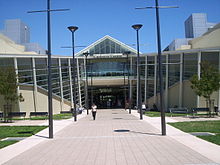EurovisionNim (talk | contribs) No edit summary |
Undid revision 617026179 by EurovisionNim (talk) Poor quality and one fountain photo is enough |
||
| Line 2: | Line 2: | ||
[[Image:Canberra centre ainslie avenue.JPG|thumb|The new front of the Canberra Centre on Ainslie Avenue]] |
[[Image:Canberra centre ainslie avenue.JPG|thumb|The new front of the Canberra Centre on Ainslie Avenue]] |
||
[[Image:Inside canberra centre.JPG|thumb|Inside the Canberra Centre]] |
[[Image:Inside canberra centre.JPG|thumb|Inside the Canberra Centre]] |
||
[[File:Man883ni.JPG|thumbnail|Water Fountain outside the Canberra Centre]] |
|||
{{Refimprove|date=June 2008}} |
{{Refimprove|date=June 2008}} |
||
Revision as of 10:48, 26 July 2014



Canberra Centre is a shopping centre located in Civic, Canberra, Australia. It opened on 6 March 1963 as the Monaro Mall,[1] then underwent a $220 million redevelopment and became the Canberra Centre in 1989. It was the first shopping centre in Canberra to have a car park operated by Car Park Ticket Machines and hence was designated an Australian Capital Historic Site in 1997.
History
Prime Minister Robert Menzies opened the original shopping centre, known as the Monaro Mall, on 6 March 1963. At the time it was the first Australian three-storey, fully enclosed and air conditioned shopping centre.[1] with David Jones, Marcus Clarks, Coles New World Supermarket (now closed), McEwans Hardware (now closed) and 58 speciality shops. The centre was expanded and rebranded as Canberra Centre and was opened officially by Rosemary Follet on 2 November 1989. Canberra Centre originally consisted of 4 city blocks: David Jones, Myer, City Market (a fresh food precinct) and Target. To access either City Market or Target, you had to either exit the main atrium and cross Bunda Street or access via the now-demolished travelators that ran parallel to Ainslie Avenue from the car parks.
At this time, Canberra Centre was owned and managed by Canberra Advance Bank, which later became St George Bank. In 1992 Queensland Investment Corporation expressed interest in purchasing Canberra Centre and put in a 50% stake purchase of the centre. In 1993 the old Bunda Street entrance was aligned diagonally to be on the corner of Petrie Plaza and Bunda Street. Another extension occurred in 1993 of the Upper Floor fashion atrium, where Pumpkin Patch is now. It was not until 2002 when a major expansion occurred, by extending the atrium by crossing over Bunda Street and closing Ainslie Avenue to allow access to City Market and Target without going outdoors. By this time, the original atrium was under refurbishment. The columns were painted in shades of white and dark green, replacing the previous watery-blue and maroon. Balustrades were re-fitted with stainless steel and painted black, replacing the brass and maroon. The Lower Ground Floor replaced all the brass and maroon chairs and tables, with plastic black and white ones. The Centre Court fountain was removed and replaced with a 360 TV. The centre clock, which ran up 3 levels, was removed due to being maroon and brass. All the toilets were refurbished and centre signage was replaced, again due to being brass letters on maroon wood.
Further expansions were completed in late 2006, this time closing half of the City Market Car Park and City Market for retail space. The new mall has added another 100 stores and relocated City Market (now called the Fresh Food Precinct). Big W, Dendy Cinemas, Aldi, Dick Smith PowerHouse and Amart Allsports along with a second food court were all new additions to the centre. On the northern end of Bunda Street, Canberra Centre's new dining and entertainment precinct, North Quarter houses restaurant like Nando's, Kingsleys Steak & Crabhouse, Wagamama, Cream, Sammy's Kitchen, Babar and Baskin-Robbins on street level and indoor. On the upper ground level of North Quarter resides Dendy Cinemas and a food court. Some of the North Quarter food court stores are: Sushi World, KFC, Ali Baba and Pie Face. Some other speciality shops in the North Quarter food court area is: Kathmandu and Rebel Sports.
On 28 February 2007, a severe thunderstorm known as a "supercell" passed over Canberra causing flash flooding, severe hail and property damage. The Canberra Centre along with the Australian National University and Campbell High School sustained heavy damage with flooding and damage to internal fit out.[2] Severe damage was inflicted on most parts of the centre including the brand new expansion. The first sign of trouble for those inside the centre came when water began pouring from the ceiling of Dendy Cinema. After ten minutes, staff began a hasty evacuation. Borders (now closed) also sustained heavy damage and flooding.[3]
In mid - 2013 the lower ground level food court was closed due to its refurbishment that will finish late - 2013. The David Jones lower ground level closed as well. Myer lower ground level continued to open. On Thursday October 31 2013 the new Refurbished Lower Level Food Court was opened so as the Myer and David Jones lower ground. Some of the old food outlets are Ali Baba, Mcdonald's, Subway and Sumo Salad. Some of the new food outlets are Hanachi, Hokka Hokka, Pure & Natural, Touch of India, Burger Edge, Hero Sushi, Indo, Mad Mex, Roll'd and Xpresso Bar. Other retailers that have opened in the Lower Ground Food Court are Dymocks, Flight Centre and Priceline Pharmacy.
Tenants
Canberra centre is 89,500 m² in size. The centre now features over 310 speciality retailers, numerous food outlets and several major retailers including:
- Target (7,775 m²)
- David Jones (1 and a half Floors)
- Myer (3 Floors)
- Supabarn (4,056 m²)
- Big W (7,678 m²)
- JB HiFi
- Apple Store
- Zara
The centre also features a Dendy Cinema with 9 theatres and 2 premium lounges.